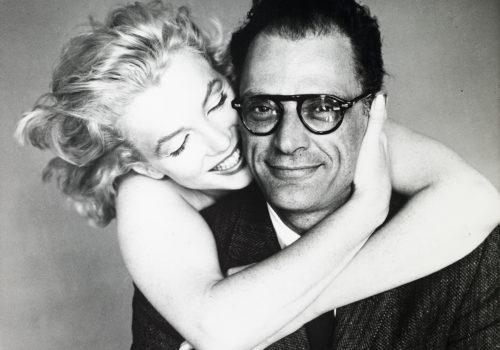The Smithsonian’s National Museum of American History presents in rotation extraordinary Richard Avedon portraits spanning two decades and curated from the museum’s extensive photo history collection. The latest iteration of the “(re)Framing Conversations: Photographs by Richard Avedon, 1946–1965” exhibition is scheduled to run through 2024.
I have 3 very beautiful memories of Richard Avedon.
The first: it was thanks to him that I met Roland Barthes.
“I would like to be published in PHOTO but I want my images to be accompanied by a text by Barthes.”
So I went to see the master in his lair: the bar of the Port Royal hotel.
Amused and above all passionate about photography, he accepted.
3 times he wrote about Avedon, but it is the first text that I prefer.
The 4th time, I received a very short note: “No, I will not write about his book. This one is only dedicated to women and you know women are not my strong point.”
I remember 5 or 6 meetings in the bar where I listened to him in amazement.
I made someone happy at that time: Hervé Guibert who worked for the magazine “20 ANS” in the Filipacchi group like PHOTO on the Champs Elysées; Hervé one day confided to me his dream of knowing Barthes.
I organized the meeting. They became very close.
The second memory is an annual awards evening at ICP, the International Center of Photography in New York.
Bourdin received the fashion prize, he couldn’t refuse it, it was awarded to him via L’Égoiste, the fabulous magazine of Nicole Wisniak.
I had plotted for Bourdin to obtain this distinction.
Knowing this from Nicole, Avedon had taken a table in honor of Bourdin where I found myself with him, Nicole, Bourdin, Samuel his son and Norma Stevens his legendary studio director.
It was Annie Leibovitz who gave the speech about Guy that evening.
The last memory concerns Match, Roger Thérond (Editor in Chief) and Avedon.
One day in the 1990s, the New Yorker published a fabulous 24-page fashion portfolio with as only models: a top model and a skeleton;
I was living in New York at the time. Roger ordered: “We need these images!”
Roger, there is a cold between Avedon and Match. The contract was not completely respected when it was last published!
It’s nothing. Do not worry ! Dick forgot!
Dick had not forgotten.
“Roger likes my images and wants them for Match, I’m delighted!
So here it is: if Match republishes the 24 pages, it’s free. If Match publishes 16 pages: that’s $10,000. If Match publishes 12 pages: that’s $20,000. If Match publishes 8 pages it’s $40,000…”
Match could only publish 8 pages, Avedon knew that.
Match paid $40,000; Avedon was ecstatic.
Jean-Jacques Naudet
In November 1962, the National Museum of American History hosted Avedon’s very first one-man exhibition that included a range of photographic materials, including photographs, proof prints, contact sheets, a printing plate and more. Avedon gifted the whole of that show to the museum followed shortly by two additional donations of his work including photographs and negatives. It is from those gifts that “(re)Framing Conversations: Photographs by Richard Avedon 1946–1965” are drawn.
Presented in conjunction with Avedon’s Centennial year, the exhibit offers both beauty and stark realism from a time when photographic film dominated. Internationally recognized as one of the 20th century’s most influential photographers, Avedon’s photography captured depth and dimension, embracing the emotions, psychology and aging of his subjects. Though high fashion brought him his initial fame, his passion for social and political issues became evident as his popularity rose.
The exhibition’s themes of politics, personal decision making, and identity are explored in six sections with questions around music, marriage, women and politics, who decides what’s sexy, can we change our minds, and who do you stand with. Included in the exhibit is a living room with a rotation of magazines from the 1940s through the 1960s for visitors to peruse, as well as interactive tabletops about portraiture, encouraging visitors to sit, pause, reflect and engage. Visitors can use their phone to access visual descriptions with QR codes located throughout the exhibition.
“As a history museum holding a vast and exceptional collection of photography, we are pleased to reveal how fine art provides a key lens to understand and explore the nation’s complicated history,” said Anthea M. Hartig, the museum’s Elizabeth MacMillan Director. “The visual impact of Avedon’s photographs capture some of the cultural and social tensions of the era through the mass media platform of magazines which he used masterfully as one of the nation’s culturemakers.”
“Photographs embody social, cultural, and political messages that we quickly absorb, whether we know it or not,” said Shannon Perich, curator of the photographic history collection. “Revisiting these historical photographs we can contemplate people of the past whose actions continue to resonate today, and point to our contemporary ability to continue to impact American culture by what music we listen to, how we engage with issues that matter to us, and who we vote for. Avedon’s portraits humanize people that have been elevated through history reminding us that we are all people who have power. We just have to decide how we are going to employ it.”
“(re)Framing Conversations” is made possible by support from Judy and Leonard Lauder, with additional funding from Marcia and Frank Carlucci and the William Talbott Hillman Foundation.
https://www.americanhistory.si.edu/explore/exhibitions/richard-avedon-1946-1965
National Museum of American History
1300 Constitution Ave NW,
Washington, DC 20560
https://www.americanhistory.si.edu/
















